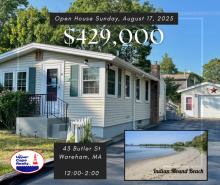Public hearing addresses proposed bylaws
The Planning Board on Monday heard from citizens about its proposals for Town Meeting, which begins on October 28. Here's a wrap up of the discussions.
Transfer of Development Rights
After listening to concerns from citizens voiced at a public hearing Monday, October 22, the Planning Board voted to hold a Transfer of Development Rights zoning bylaw until spring Town Meeting.
The bylaw has been in the works since 2005.
The bylaw would allow the owners of land in two environmentally sensitive areas of town to sell their “development rights” to landowners in less sensitive areas who want to develop areas more densely than current zoning allows.
The long term goal of the bylaw is to protect the more environmentally vulnerable areas of town, while at the same time allowing more intensive development in areas that could benefit from development.
It would allow for higher density development in some areas, while leaving other areas undeveloped.
Engineer Charles Rowley pointed out a couple of flaws in the bylaw that the board will revisit before spring.
"I think you're looking at some serious issues...In its present form I think you've got some problems."
One such issue, he says, is that "receiving parcels" are not specifically defined.
The bylaw designates some pieces of land “sending” areas, where owners would be encouraged to sell development rights and thus allow the property to remain undeveloped.
This would allow the development rights to be transferred to the "receiving parcel", would then be able to develop more densely than it was previously able.
Rowley pointed out that in its current form, the bylaw describes the parcels by neighborhoods, for example, Wareham Village, Onset Village and East Wareham along Cranberry Highway.
"These have no specific definitions," Rowley said. "Where is the border of East Wareham? Tihonet? Parker Mills? It's got to be by streets, or it's got to be by metes and bounds."
Update of flood maps
Town Meeting voters will be asked to approve a bylaw handed down by the Federal Emergency Management Agency (FEMA) that redraws the flood maps in Wareham, and has residents worried about steep increases in flood insurance.
The Planning Board did not weigh in on the bylaw in the form of a vote at its Monday night meeting because members wanted to get advice from Town Counsel on some aspects of it.
The new maps have the flood zones reaching further inland, increasing the number of residents required to purchase flood insurance. And the double whammy of the increasing insurance rates and the expanding flood zones has citizens and officials concerned.
Towns across the country are dealing with the rising cost of flood insurance following the passage of the Biggert-Waters Flood Insurance Reform Act. The goal of the legislation was to lessen the burden of the federal flood insurance program on taxpayers.
Tax money will no longer subsidize the flood insurance program for homes built before the national flood insurance program was established. In addition, there will be no more properties "grandfathered in" to previous flood insurance rates because they met the flood-zone requirements in place when they were built.
This means that property owners will be paying for insurance based on the actual risk posed to their home.
Congress is in the process of revisiting the legislation, and the Wareham Selectmen have sent a letter to U.S. Representative William Keating expressing concern about the affect of the law of property owners.
This concern has apparently enticed some residents to rally against the new flood maps.
"I know there is a movement afoot to vote all these down," said Planning Board Chair George Barrett. "I do not advise you to do this."
He pointed out that municipalities that fail to adopt the new maps will be subject to sanctions including, but not limited to: Inability of residents to purchase flood insurance; Non-renewal of existing flood insurance policies; No federal grants or loans for development in identified flood hazard areas under federal programs administered by federal agencies such as the Department of Housing and Urban Development or the Environmental Protection Agency.
"It's not a pleasant situation. Flood insurance doesn't just affect the big waterfront properties you see," Barrett said, pointing out that as the maps are drawn and the passage of the Biggert-Waters act, houses that are far from the waterfront could also be subject to large increases in flood insurance rates.
Selectman Patrick Tropeano showed up to voice his concern on the matter.
"If it's so important then why don't they mandate it," Tropeano asked rhetorically. "They don't mandate it so five years from now they can say, 'Well, you voted for it.'"
He went on to say that the rates are inflicting an undue financial burden on local people: "Some people, right now, their flood insurance is twice their mortgage."
Although the town cannot avoid passing the bylaw without incurring sanctions, some Massachusetts towns are in the process of filing a lawsuit against FEMA over the new insurance rates.
"All we can do is join the lawsuit once it's in place," said Selectman Alan Slavin, who also serves as liaison to the Planning Board.
"And will Wareham do that?"one woman in the audience asked.
"Of course we will," Slavin replied.
Slavin noted that Wareham is one of many towns facing this issue: "There's been a lot of kick back from all across the country."
Marijuana treatment center zoning bylaw
Town Meeting voters will decide whether to allow medical marijuana treatment centers to operate in the town's "institutional zone."
Wareham placed a moratorium on medical marijuana treatment centers last spring, and it will expire in spring 2014. The moratorium was established while Wareham waited for the state Department of Public Health to hand down regulations.
Massachusetts voters approved a ballot question in November 2012 that legalized the prescription of marijuana by physicians for medical purposes. Since then, officials have been trying to determine where any treatment centers would operate in town.
The institutional zone largely includes the area around Tobey Hospital, underscoring the goal of housing such a center near other medical facilities, but it also stretches toward High Street and down Marion Road near the middle and high schools.
"It includes more than just the area around Tobey Hospital," engineer Charles Rowley pointed out.
This bylaw does not establish an actual treatment center, it merely establishes the zoning guidelines for one.
"If you don't have someplace to put it, they can put it anywhere," Selectman Patrick Tropeano pointed out.
State regulations mandate that anybody who wishes to open a medical marijuana dispensary have $500,000 in escrow before the person applies apply for a license.
The law allows for residents who receive permission from their doctors to possess a 60-day supply of marijuana, which is defined by the state Department of Public Health as 10 ounces. In ten ounces there are approximately 283.5 grams. One gram is the approximate equivalent of one joint.
The state has narrowly defined who qualifies for marijuana prescriptions in the hopes of preventing abuse of the law. In order to qualify, a person must be diagnosed with Hepatitis C, AIDS, glaucoma, multiple sclerosis, or "other conditions as determined in writing by a qualifying patient’s physician."
There are 35 licenses available for marijuana treatment centers in the state, and nineteen applications have been filed for five available licenses in Plymouth County.
Sign bylaw
Town Meeting voters will be asked to approve a bylaw that expands regulations regarding signs in Wareham.
The new bylaw clearly defines what kinds of signs are allowed where, how big they're allowed to be, and in what manner they are allowed to be illuminated, among other things.
The goals outlined in the bylaw are: To reduce potential distractions and obstructions of signs that would adversely affect traffic safety; To discourage excessive visual competition in signage; To preserve and enhance the character of the town.
At the Planning Board hearing, Selectman Patrick Tropeano expressed concern about the potential effect that strictly regulating the types of signs people may display on businesses.
"I think this bylaw doesn't hurt anybody but the small businesses," he said, noting that when it comes to chains like McDonalds or Walmart, the size and ubiquity of the businesses renders any limits on signage for them pointless.
"I'm not saying our sign bylaw doesn't need tweaking, but we have a sign bylaw in place that's never been enforced."
The Director of Inspectional Services will be responsible for enforcing the regulations. Violations of any part of the bylaw will incur a fine of $250, and each day that the violation continues will be counted as a separate offense.












